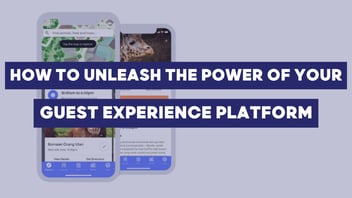We had so much fun thinking of ways to use AI to enhance our guest experience, that we decided to come up with four additional ways you can use this technology as well as one more consideration about its long-term impact.
Read on for some creative ways to do so, and don’t forget to also check out part one here.
Interactive Storytelling
Picture this: an exhibit where AI guides visitors through a narrative journey, adapting in real-time to their reactions and specific interests. This could be as vivid as a virtual guide through an ancient civilization, where visitors can ask questions and the story unfolds in a choose-your-own-adventure format or an interactive art display that changes its story elements based on the viewer’s movements. This use of AI not only makes cultural experiences more engaging but also personalizes them, allowing each visitor to have a unique encounter that changes with each new visit.
Go with the flowAI can also analyze visitor flow patterns and heat maps to identify popular exhibits and parts of your attraction that need to get more congested. As heat mapping is already something many cultural attractions do, automating this aspect with help from AI as well as seeing new trends from the data that you may not have already noticed can guide decision-making for exhibit placements, improving visitor experiences and ensuring safety during their time with you.
Sustainability supportOn top of visitor heat mapping, AI can also analyze previous heating/cooling and electrical bills alongside visitor flow and see where energy can be saved. For example, perhaps you can put in motion lighting in bathrooms, automatically change your heating based on the week’s forecast as opposed to having a manual schedule, or take note of particular product purchases that can be exchanged for items that are more compostable or recyclable. Little changes like this can make a big impact on your attraction’s environmental footprint and AI can help automate these changes.
The ultimate production assistantArtificial intelligence isn't just revolutionizing guest experiences; it also transforms the backend operations of cultural attractions supporting departments across the business to focus on more impactful, guest-facing work. For example, within the marketing and communications side of the business, AI can handle routine tasks like data analysis and industry research, freeing teams for creative strategy and more meaningful guest engagement. From an operations and maintenance angle, it can monitor ingredients used and when it might be useful to order more supplies. track changes in ticketing preferences, and other predictive analytics allowing these departments to prioritize enhancing visitor safety and comfort.
Consideration: AI (Machine learning) vs. algorithmsAs we explore the potential of AI, particularly the advanced capabilities offered by machine learning, we're not just following trends but pioneering new ways to enrich guest experiences. Machine learning models represent a significant leap forward, offering nuanced insights and automations that traditional algorithms cannot, marking a new frontier in our quest to provide unparalleled cultural experiences.
The future is br-AI-ght
Bad puns aside, we’re excited to see what the future of AI tech looks like for cultural attractions. It remains to be seen what happens next with this technology and while we’re certainly no experts, we believe AI could be a new frontier for a better guest experience.
Read more about the latest in technology in the cultural attraction industry on our blog here.



